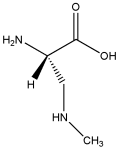By Roberta Attanasio, IEAM Blog Editor

BMAA, Wikimedia Commons, licensed under
BMAA, or beta-N-methylamino-L-alanine, is a potent neurotoxin linked to the development of neurodegenerative diseases such as amyotrophic lateral sclerosis (ALS, often referred to as Lou Gehrig’s disease), Alzheimer’s, and Parkinson’s. Produced by virtually every known species of cyanobacteria, BMAA increases in concentration as it moves up the food chain—a process known as biomagnification or bioaccumulation—in both aquatic and terrestrial ecosystems. Continue reading
